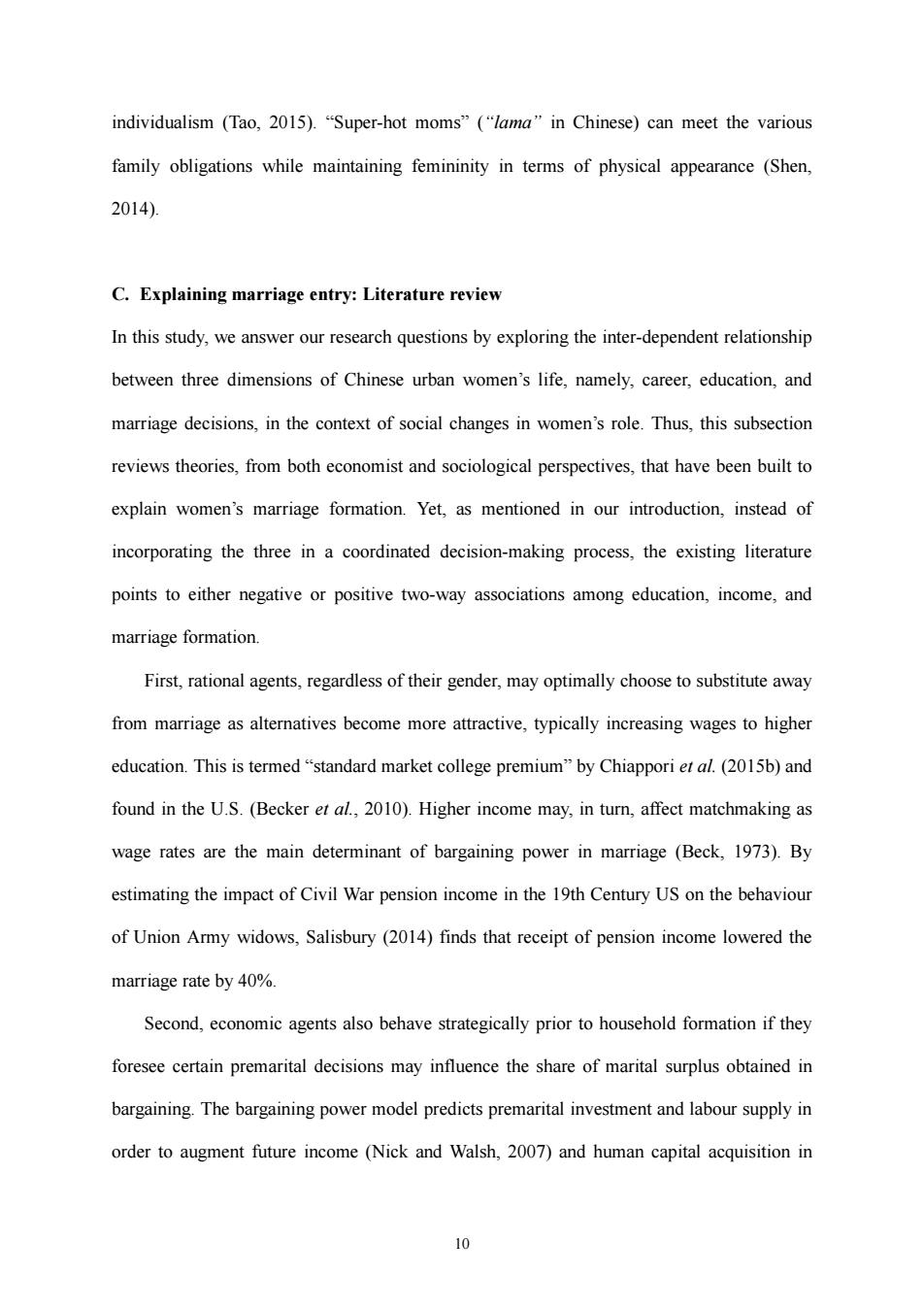正在加载图片...

individualism(Tao,20lS).“Super-hot moms”(“lama”in Chinese)can meet the various family obligations while maintaining femininity in terms of physical appearance (Shen, 2014). C.Explaining marriage entry:Literature review In this study,we answer our research questions by exploring the inter-dependent relationship between three dimensions of Chinese urban women's life,namely,career,education,and marriage decisions,in the context of social changes in women's role.Thus,this subsection reviews theories,from both economist and sociological perspectives,that have been built to explain women's marriage formation.Yet,as mentioned in our introduction,instead of incorporating the three in a coordinated decision-making process,the existing literature points to either negative or positive two-way associations among education,income,and marriage formation. First,rational agents,regardless of their gender,may optimally choose to substitute away from marriage as alternatives become more attractive,typically increasing wages to higher education.This is termed"standard market college premium"by Chiappori et al.(2015b)and found in the U.S.(Becker et al.,2010).Higher income may,in turn,affect matchmaking as wage rates are the main determinant of bargaining power in marriage (Beck,1973).By estimating the impact of Civil War pension income in the 19th Century US on the behaviour of Union Army widows,Salisbury (2014)finds that receipt of pension income lowered the marriage rate by 40%. Second,economic agents also behave strategically prior to household formation if they foresee certain premarital decisions may influence the share of marital surplus obtained in bargaining.The bargaining power model predicts premarital investment and labour supply in order to augment future income (Nick and Walsh,2007)and human capital acquisition in 1010 individualism (Tao, 2015). “Super-hot moms” (“lama” in Chinese) can meet the various family obligations while maintaining femininity in terms of physical appearance (Shen, 2014). C. Explaining marriage entry: Literature review In this study, we answer our research questions by exploring the inter-dependent relationship between three dimensions of Chinese urban women’s life, namely, career, education, and marriage decisions, in the context of social changes in women’s role. Thus, this subsection reviews theories, from both economist and sociological perspectives, that have been built to explain women’s marriage formation. Yet, as mentioned in our introduction, instead of incorporating the three in a coordinated decision-making process, the existing literature points to either negative or positive two-way associations among education, income, and marriage formation. First, rational agents, regardless of their gender, may optimally choose to substitute away from marriage as alternatives become more attractive, typically increasing wages to higher education. This is termed “standard market college premium” by Chiappori et al. (2015b) and found in the U.S. (Becker et al., 2010). Higher income may, in turn, affect matchmaking as wage rates are the main determinant of bargaining power in marriage (Beck, 1973). By estimating the impact of Civil War pension income in the 19th Century US on the behaviour of Union Army widows, Salisbury (2014) finds that receipt of pension income lowered the marriage rate by 40%. Second, economic agents also behave strategically prior to household formation if they foresee certain premarital decisions may influence the share of marital surplus obtained in bargaining. The bargaining power model predicts premarital investment and labour supply in order to augment future income (Nick and Walsh, 2007) and human capital acquisition in